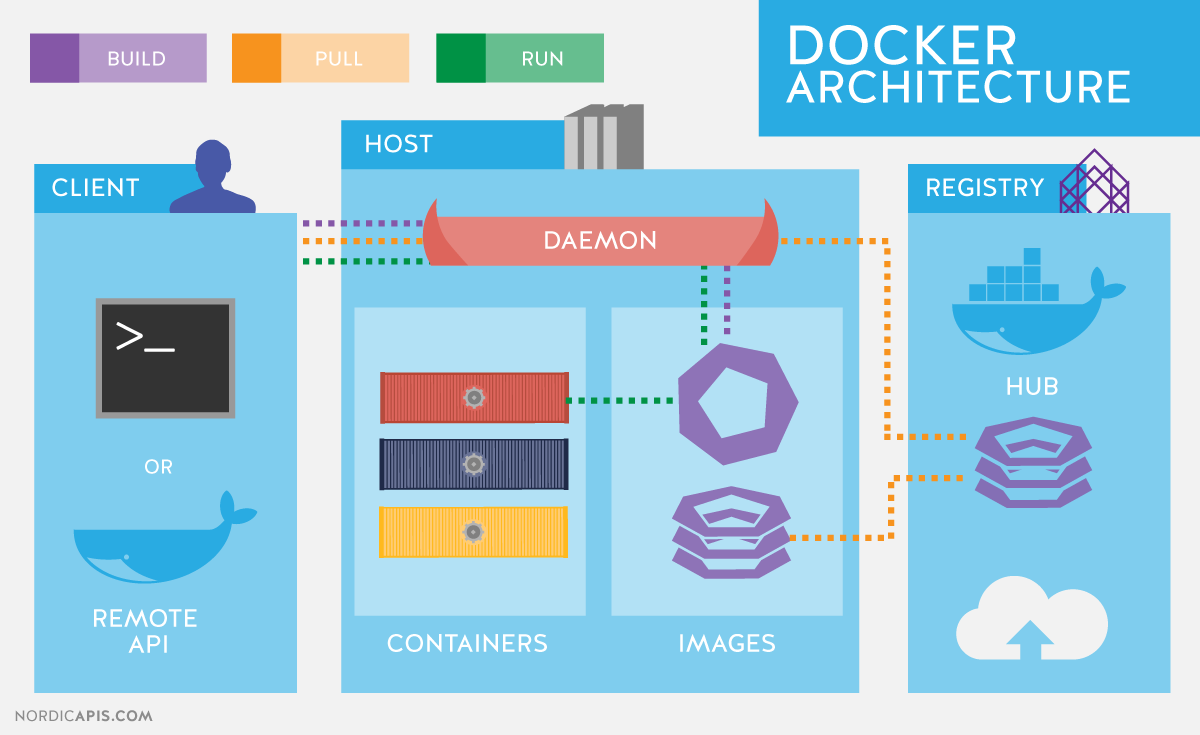This is an introductory workshop to Docker. It is meant to be suited for everyone: from beginners to intermediate users.
We've just found this new messaging app — Rocket.chat (demo) and we want to run it on our server.
Let's see how would the manual installation look like.
That's pretty complicated, is there an easier way?
We can run rocket.chat just by executing these two commands:
$ sudo docker run \
--name=mongo \
--net=host \
-v /etc/localtime:/etc/localtime:ro \
mongo:3.4
$ sudo docker run \
--name=rocket \
--net=host \
-e MONGO_URL=mongodb://0.0.0.0:27017 \
-v /etc/localtime:/etc/localtime:ro \
rocket.chat
Rocket.chat is now running inside docker containers and we can check it out:
$ xdg-open http://localhost:3000
CentOS users are advised to use yum package manager, Fedora users should run
dnf. Users of other linux distributions and operating systems are on their
own.
So let's install docker:
$ sudo yum install docker
And let's start it:
$ sudo systemctl start docker
Is it running?
$ systemctl status docker
Is it really running?
$ sudo docker version
Docker is a platform to manage complete lifecycle of applications including building, packaging, running, distributing, deploying, scaling. Docker uses linux containers for running applications and its own format to distribute the application images.
Docker tool is using client & server architecture:
Source: http://nordicapis.com/api-driven-devops-spotlight-on-docker/
Containers are made of a writable layer on top of an image. Once you start a container, it's also a traditional linux process.
Let's create a container:
$ sudo docker create -ti --name=toy fedora:25 bash
Is it running?
$ sudo docker inspect toy
$ sudo docker start toy
$ sudo docker attach toy
Let's change something!
$ echo "Just testing." >/fun
What about the writable layer thingy?
$ sudo docker diff toy
$ sudo docker start mongo
$ sudo docker inspect mongo | grep Mounts
$ sudo docker run -d --name=other-mongo \
-v /etc/localtime:/etc/localtime:ro \
-v $PWD/mongo-data:/data/db mongo:3.4
Ehm, can we have some output please?
$ sudo docker logs other-mongo
I meant what's going on right now!
$ sudo docker logs -f other-mongo
$ sudo docker run -dit --name our-httpd -v "$PWD":/usr/local/apache2/htdocs/ httpd:2.4
I want to access the web server from internet.
$ sudo docker rm our-httpd
$ sudo docker run -dit -p 8000:80 --name our-httpd -v "$PWD":/usr/local/apache2/htdocs/ httpd:2.4
The answer:
$ alias docker="sudo docker"
$ alias d="sudo docker"
The other answer:
$ ls -lha /run/docker.sock
$ sudo docker run -ti -v /:/hostfs registry.fedoraproject.org/fedora:26 bash
We can start our journey by launching a shell prompt inside a container. Let's have a closer look at the rocket.chat container:
$ sudo docker exec -ti rocket bash
$ cat /etc/os-release
$ ps aux
Let's go back to host.
How does the container look?
$ htop
What are the technologies containers are using?
$ sudo docker run -ti --rm registry.fedoraproject.org/fedora:26 bash
$ dnf install -y procps-ng iproute
$ ls -lha /proc/self/ns/
$ mount
$ ps aux
$ hostname
$ ip a
Container images are a method to distribute applications. They are being built using docker, then uploaded to docker registries so they can be distrbuted.
Here's the rocket.chat image inside Docker Hub, the registry provided by Docker Inc.
Images are composed of metadata and layered filesystem trees. These filesystem trees contain your service or application plus all its dependencies.
Huh, what?
Okay, let's take it step by step.
First we need to download the image from the registry, that's what we already did when we ran the rocket.chat container.
Let's inspect the filesystem tree now:
$ sudo docker create --name image-content rocket.chat /bin/false && \
mkdir -p ./image && \
sudo docker export image-content | tar -x -C ./image
$ ls -lha ./image
But you said layered!
Source: https://docs.docker.com/engine/userguide/storagedriver/imagesandcontainers/
$ mkdir -p layered-image && \
sudo docker save rocket.chat | tar -x -C ./layered-image
$ mc ./layered-image
I hope it's clear that images are not containers.
I am interested in hearing your feedback! This presentation is still a prototype. What would you change?
Feel free to open an issue or send a pull request.
- Have a beer.
- Listen Vasek's talk.
- Managing containers using ansible
- Advanced container deep-dive

